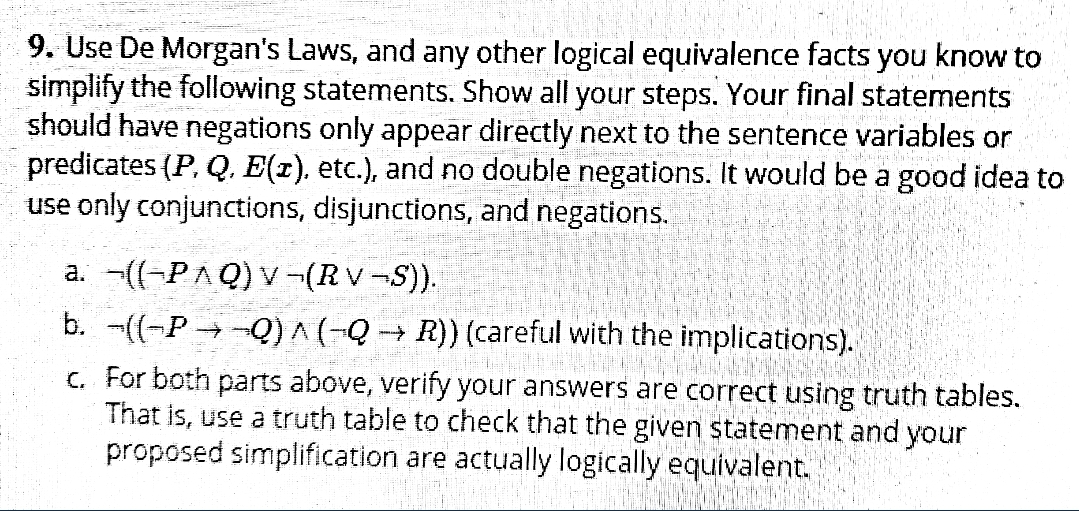
Advanced Engineering Mathematics
10th Edition
ISBN: 9780470458365
Author: Erwin Kreyszig
Publisher: Wiley, John & Sons, Incorporated
expand_more
expand_more
format_list_bulleted
Question

Transcribed Image Text:9. Use De Morgan's Laws, and any other logical equivalence facts you know to
simplify the following statements. Show all your steps. Your final statements
should have negations only appear directly next to the sentence variables or
predicates (P, Q. E(r). etc.), and no double negations. It would be a good idea to
use only conjunctions, disjunctions, and negations.
a. -((-PAQ) V ¬(RV-S).
b. -(-P-Q)^ (-Q → R)) (careful with the implications).
C. For both parts above, verify your answers are correct using truth tables.
That is, use a truth table to check that the given statement and your
proposed simplification are actually logically equivalent.
Expert Solution
This question has been solved!
Explore an expertly crafted, step-by-step solution for a thorough understanding of key concepts.
This is a popular solution
Trending nowThis is a popular solution!
Step by stepSolved in 3 steps with 3 images

Knowledge Booster
Similar questions
- Material implication says that which two connectives are basically "the same" in that whenever you choose to express a statement with one connective, you could have used the other (without having to make many other adjustments)? a. Biconditional → O b. Conjunction A c. Disjunction V d. Conditional →→arrow_forwardTranslate the following argument into a first-order language: Every instance of knowledge is an instance of non-accidentally true belief. Every Gettier case is an instance of accidentally true belief. Some cases of justified true belief are Gettier cases. --------------------------------------------------------------------- Some cases of justified true belief are not instances of knowledge.arrow_forwardHelp me fast so that I will give Upvote.arrow_forward
- Translate the given statement into symbolic form. Be sure to define all pred- icates used. Use the variable a with domain D = {a : a is an animal } as your main variable. Then, negate the symbolic statement. In your answer, negations should appear only in front of predicates. Finally, rewrite the negated statement clearly in plain English. "Any animal that is wild can be tamed." 2.arrow_forwardWhich of the following represents the negation of the statement: "The cat sleeps and the mouse does not hide."arrow_forwardPlease help me with the three questions (d,e,f) in the image below. Show all work. Thank youarrow_forward
- Let p, q, and r represent the following simple statements. p: I eat bananas. q: I like ice cream. r I like to eat. Write the following compound statement in its symbolic form. If I do not eat bananas then: I do not like ice cream and I do not like to eat. The symbolic form isarrow_forwardTranslate the following sentence in terms of predicates, quantifiers, and logical connectives. Choose your own variables and predicate statement symbols as needed and define each of them clearly. Specify the domainarrow_forwardplease change this sentence to fol (first order logic) Hanry is a student in Bina Nusantara University and that makes him to be called binusian. In Binus, there is a prestigious award so called a star.arrow_forward
- Determine if the following statements are logically equivalent, negations or neither: ~p➡q ; ~(p∧q) Are the statements logically equivalent, negations, or neither? ________________arrow_forward8. Rewrite the following argument as a conditional statement qarrow_forwardTulips The diagram shows the relationship between two sets. Flowers aUse the diagram to write a statement beginning with the word "all," "some," or "no" that illustrates the relationship between the sets. b.Determine if the statement in part (a) is true or false. If it is false, write its negation. a. Choose the correct statement below that illustrates the relationship between the sets. O A. No tulips are flowers. O B. All flowers are tulips. OC. All tulips are flowers. O D. Some flowers are tulips. O E. Some tulips are flowers. b. Is the statement in part (a) true or false? O A. False; its negation is "Some tulips are not flowers." O B. False; its negation is "Some flowers are not tulips." O C. False; its negation is "Some flowers are tulips." OD. False; its negation is "No tulips are flowers." O Time Remaining: 01:58:05 Next MacBook Air 4) 0 9. > FS) F7 esc F2 F4 #3 & * 2$ 4 2 3 5 6. 7 8 9 delete Q W E R Y A S F J K ck C V M Narrow_forward
arrow_back_ios
SEE MORE QUESTIONS
arrow_forward_ios
Recommended textbooks for you
 Advanced Engineering MathematicsAdvanced MathISBN:9780470458365Author:Erwin KreyszigPublisher:Wiley, John & Sons, Incorporated
Advanced Engineering MathematicsAdvanced MathISBN:9780470458365Author:Erwin KreyszigPublisher:Wiley, John & Sons, Incorporated Numerical Methods for EngineersAdvanced MathISBN:9780073397924Author:Steven C. Chapra Dr., Raymond P. CanalePublisher:McGraw-Hill Education
Numerical Methods for EngineersAdvanced MathISBN:9780073397924Author:Steven C. Chapra Dr., Raymond P. CanalePublisher:McGraw-Hill Education Introductory Mathematics for Engineering Applicat...Advanced MathISBN:9781118141809Author:Nathan KlingbeilPublisher:WILEY
Introductory Mathematics for Engineering Applicat...Advanced MathISBN:9781118141809Author:Nathan KlingbeilPublisher:WILEY Mathematics For Machine TechnologyAdvanced MathISBN:9781337798310Author:Peterson, John.Publisher:Cengage Learning,
Mathematics For Machine TechnologyAdvanced MathISBN:9781337798310Author:Peterson, John.Publisher:Cengage Learning,


Advanced Engineering Mathematics
Advanced Math
ISBN:9780470458365
Author:Erwin Kreyszig
Publisher:Wiley, John & Sons, Incorporated

Numerical Methods for Engineers
Advanced Math
ISBN:9780073397924
Author:Steven C. Chapra Dr., Raymond P. Canale
Publisher:McGraw-Hill Education

Introductory Mathematics for Engineering Applicat...
Advanced Math
ISBN:9781118141809
Author:Nathan Klingbeil
Publisher:WILEY

Mathematics For Machine Technology
Advanced Math
ISBN:9781337798310
Author:Peterson, John.
Publisher:Cengage Learning,

